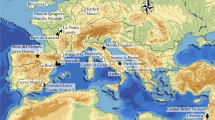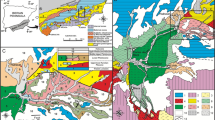Abstract
At the end of Member 2 times, remnant mammillary-form stalactites in the roof and wall contacts show that an irregular wedge-shaped space existed from the Classic Section out to the Cone area. It was into this space that hyenas and other denning animals were able to gain access from an as yet unfilled Cone area. During the mining operations of the 1920’s, Eitzman (1958) recollects entering an impressive bone breccia resembling a charnel house. We suggest that it is most probable that the Grey Breccia corresponds to his main breccia as only the area on top of Member 2, between the dolomite walls, roof and stalagmite boss has the required volume. It also lies at the end of an incline first dug by the miners, (still in existence), and at the end of which he was able to note some of the deposits. The bone breccias at the same level at the back of the Cone suggest that other dens were created at about this time.
As the roof continued to retreat upslope and more material was washed in or fell in from the surface so more sediment was winnowed into the back of the Cone. At some stage this allowed prey animals to enter the Cone area and gain access between the speleothem barrier to the area of the Classic Section. As most Australopithecine fragments came from this breccia, it seems likely that, as with Swartkrans, the hominid fragments are the result of predation. Then as sediments continued to wash into the Cone area, the Classic Section and the back of the Cone became inaccessible for denning purposes.
Large speleothem remnants embedded in sediment starting part-way up the Cone shows that a roof continued to exist in this area for some time. In fact, even today, although bits of speleothems can be found in the eroded hardened surface sediments there are few, if any, dolomite blocks. We presume that they were removed along with the upper part of the infilled, cavern along with the country rock as the surface continued to erode.
Although it may not be possible to reconstruct a complete strati-graphic sequence involving the whole of the site, we have presented summary of evidence here that shows it is possible to trace stratigraphic relationships from the base of the Ancient Entrance to the top of the Cone and which includes the Grey Breccia and the two other bone breccias. Present work is focussed on completion of a new chronology by comparing our site magnetostratigraphy with the global polarity timescale.
The speleothem deposition today in any of the caves of the Makapansgat area, with its annual rainfall of about 700mm, is extremely low. It is commonly recognised by karst geomorphologists (eg, Ford and Williams, 1989) that massive deposits of speleothem are characteristic of humid tropical to semi-tropical karsts. Hence, at the time of their formation some 3 Ma or more ago, the massive speleothem deposits are evidence for a warmer, and certainly a much wetter, climate than that of today.
Similar content being viewed by others
References
Brain, C.K., 1958. The Transvaal ape-man bearing cave deposits. Transvaal Museum memoir, 11, 1–131.
Brain, C.K., 1981. The Hunters or the Hunted.: An introduction to African Cave Taphonomy, University of Chicago Press, Chicago and London. 365pp.
Eitzman, W.I., 1958. Reminiscences of Makapansgat Limeworks and its bone-breccia layers. South African Journal of Science, 54, 177–182.
Ford D.C. and Williams, P., 1989. Karst Geomorphology and Hydrology. Unwin Hyman, London, 601 pp.
Hill C.A., and Forti, P., 1997, Cave Minerals of the World. National speleological Society, Huntsvill, Alabama, USA, 2nd Edition, 463pp.
Latham, A.G., Herries, A.I.R., Quinney, P., Sinclair, A.G.M. and Kuykendall, K., 1999, The Makapansgat Australopithecine site from a speleological perspective. 61–78, in Geoarchaeology: exploration, environments, resources, Editor A.M. Pollard Geological Society Special Publication No 165. London.
Maguire, J.M., Pemberton, D. and Collett, M.H. 1980, The Makapansgat Limeworks Grey Breccia: Hominids, hyaenas, hystricids or hillwash? Palaeontologia Africana, 23, 75–98.
Maguire, J.M., Schrenk, F., and Stannistreet, I.G., 1985. The lithostratigraphy of the Makapansgat Limeworks australopithecine site: some matters arising. Annals of the Geological Survey of South Africa, 19, 37–51.
Partridge, T.C. 1979. Re-appraisal of lithostratigraphy of Makapansgat Limeworks hominid site. Nature, 279, 484–488.
Partridge, T.C., 2000, Hominid-Bearing Cave and Tufa Deposits, chapter 7 inThe Cenozoic in Southern Africa, T.C. Partridge and R.R. Maud Eds. Oxford monographs on geology and geophysics No. 40. Oxford University Press. 406 pp.
Tobias, P.V., 1997, Some little known chapters in the early history of the Makapansgat fossil hominid site. Palaeontologia Africana 33, 67–79.
Wells, L.H. and Cooke, H.B.S., 1956, Fossil bovidae from the Limeworks Quarry, Makapansgat, Potgietersrus. Palaeontologia Africana, 4, 1–56.
Author information
Authors and Affiliations
Rights and permissions
About this article
Cite this article
Latham, A.G., Herries, A.I.R., Sinclair, A.G.M. et al. Re-examination of the lower stratigraphy in the classic section, limeworks site, Makapansgat, South Africa. Hum. Evol. 17, 207–214 (2002). https://doi.org/10.1007/BF02436372
Received:
Accepted:
Issue Date:
DOI: https://doi.org/10.1007/BF02436372




